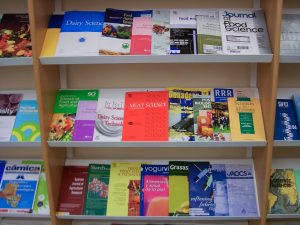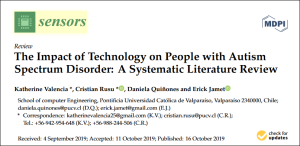Understanding Sources Types
Odds are good that your professor wants you to use certain types of textual sources in your writing. The three broad categories—popular, trade, and scholarly—have varying degrees of reliability and usefulness in college-level writing.
Recognizing Popular Sources
 Popular sources are written for an interested audience without any specialized knowledge. This is the kind of source that you’ll find on magazine racks or at the grocery store check-out.
Popular sources are written for an interested audience without any specialized knowledge. This is the kind of source that you’ll find on magazine racks or at the grocery store check-out.
Here are some examples of popular sources:
- Magazines like Time and National Geographic
- Newspapers like Wall Street Journal and Washington Post
- Popular websites like Politico and ESPN.com
- Radio and television sources like NPR (National Public Radio) and CNN (Cable News Network)
- Encyclopedias like Britannica and WebMD
While many of these sources are reputable, they often won’t be acceptable for college-level writing because they aren’t written by subject-matter experts, and they often don’t have references. Don’t plan to use these unless your professor explicitly tells you that you can or should.
Recognizing Trade Sources
 Trade publications are written for professional audiences. Most industries have print and/or electronic resources designed specifically for people working in that field. In higher education, for example, there is The Chronicle of Higher Education and Insider Higher Ed, both of which provide news and information relevant for those working in colleges and universities. There are also websites like Edutopia and AAC&U (American Association of Colleges and Universities).
Trade publications are written for professional audiences. Most industries have print and/or electronic resources designed specifically for people working in that field. In higher education, for example, there is The Chronicle of Higher Education and Insider Higher Ed, both of which provide news and information relevant for those working in colleges and universities. There are also websites like Edutopia and AAC&U (American Association of Colleges and Universities).
Many trade sources are published by professional organizations. Professional organizations provide support for people working in a particular field, and as you move into advanced classes in your major, you should ask your professors about these.
As with popular sources, many of these are quite reputable. While they are considered more useful for college-level research than popular sources, they are often not acceptable because the writing does not undergo peer review (see below), and there may be no citations. Like popular sources, check with your professor.
Recognizing Scholarly Sources
 Scholarly sources are considered the gold standard because they are written by researchers for researchers. Scholarly sources rely on a process called “peer review” whereby research articles are evaluated by other researchers in the same field for the appropriateness of their methods and accuracy of their findings. Scholarly articles generally do not get published unless they make a contribution to research in the field.
Scholarly sources are considered the gold standard because they are written by researchers for researchers. Scholarly sources rely on a process called “peer review” whereby research articles are evaluated by other researchers in the same field for the appropriateness of their methods and accuracy of their findings. Scholarly articles generally do not get published unless they make a contribution to research in the field.
You can often identify scholarly articles because they appear in publications with titles that include words like “journal” and “research.” Articles from these publications do not include images designed to draw interest; instead, they often include data-driven graphics, like charts and tables, though not in all disciplines. They also tend to have lots of citations and reference lists at the end.
While some of these articles are freely available on the internet, many of them can only be found through library databases or journal websites, and if you aren’t a subscriber, you’ll be asked to pay for access to these articles. Fortunately, college and university libraries are usually subscribers—and when they aren’t, they can still get the articles through a process called interlibrary loan. Check your library’s website for the specifics.
These sources are highly reputable, and particularly in your upper-level major courses, you will almost certainly be expected to use these for most of your textual sources. Be warned, though. These can be very difficult to read because novices and students aren’t the audience—experts are. Be sure to allow extra time to read these sources.
Understanding Primary and Secondary Sources
Beyond whether a source is scholarly or not, writers and researchers make a distinction between primary and secondary sources. Popular, trade, and scholarly sources all can be either primary sources or secondary sources. For example, a news story reporting events would be a primary source, and commentary on that reporting would be a secondary source, but both would be popular sources. Even among scholarly sources, there are primary and secondary sources.
Primary Sources
 Primary sources are first-hand accounts or documents created in historical real-time. They include texts of laws, speeches, letters, photographs, works of literature and art, and newspaper reports in which the reporter was an actual witness to the event or reporting the words of those who witnessed it. These sources are also considered highly reputable, and you may often be asked to use primary sources in your writing.
Primary sources are first-hand accounts or documents created in historical real-time. They include texts of laws, speeches, letters, photographs, works of literature and art, and newspaper reports in which the reporter was an actual witness to the event or reporting the words of those who witnessed it. These sources are also considered highly reputable, and you may often be asked to use primary sources in your writing.
Reports of original research are also primary sources because the researchers are presenting data that they have collected. A report on the findings from a study of changes in the diving behavior and habitats of whale sharks and the implications for tourism, for example, is a primary source because it explains findings based on data gathered by Gonzalo Araujo, Jessica Labaja, Sally Snow, Charlie Huveneers, and Alessandro Ponzo.
Secondary Sources
 Secondary sources involve some kind of interpretation, which means that the author is determining what is valuable about the ideas in the source.
Secondary sources involve some kind of interpretation, which means that the author is determining what is valuable about the ideas in the source.
Secondary scholarly sources include review articles and meta-analyses. Review articles pull together research findings from multiple studies to explain what is known and what needs further research in a field. For example, Katherine Valencia, Cristian Rusu, Daniela Quiñones and Erick Jamet synthesized the findings in ninety-four published studies looking at how technology affects the learning of people with autism spectrum disorder, finding that particular elements of technology, including artificial intelligence and virtual reality, promote learning for people with ASD.
Meta-analysis articles use statistics to combine smaller research studies. For example, Xue-Lei Fu, Lin Du, Yi-Ping Song, Hong-Lin Chen, and Wang-Qui Shen combined the statistical data of twenty-two smaller studies on injuries in professional snow sports to determine, among other things, that freestyle skiing has the highest rate of injury.
Don’t get caught up in whether a source is primary (original research) or secondary (interpretive). Think about which sources are going to be most useful for the intellectual work of the project you are working on. If your task is to research the effects of climate change on forests in the northeastern United States, it would be better to look at forestry data and scientific research articles than to use commentary in local newspapers about the changes.
Using Encyclopedias (Including Wikipedia)—Or Not
 If you head to your college’s library or library website, you are likely to find that there are lots of respected and specialized encyclopedias available. Dictionaries and encyclopedias can be very helpful sources for getting yourself oriented, particularly on a new topic. If you do not know much about the topic, for example, a quick read through Wikipedia’s entry on light rail can help you figure out what light rail is and how it is different from heavy rail or subway systems.
If you head to your college’s library or library website, you are likely to find that there are lots of respected and specialized encyclopedias available. Dictionaries and encyclopedias can be very helpful sources for getting yourself oriented, particularly on a new topic. If you do not know much about the topic, for example, a quick read through Wikipedia’s entry on light rail can help you figure out what light rail is and how it is different from heavy rail or subway systems.
However, your professor will almost certainly tell you that you cannot use Wikipedia as a source, and you’ve probably heard that message from your high school teachers, too. The usual reason given is that Wikipedia is crowd-sourced. Lots of people contribute to Wikipedia articles, and while there are checks on the veracity of the material, there is no guarantee that the person writing the article—or any part of the article—has any expertise on that topic.
But there’s more to it than that, at least at the college level, and the problem actually extends to all encyclopedias. These sources contain predigested information. That is, someone else has already decided what is most important about that topic and presented that information to you. In college, your professors are interested in what you think is important, and if you use an encyclopedia as a source, you aren’t doing that.
Use the References
Feel free to use Wikipedia or Britannica or WebMD (or any other encyclopedic source) to get oriented or generate ideas or narrow topics or locate other sources. But don’t use them as sources unless your professor expressly tells you to.
Key Points: Understanding Source Types
- Popular sources are written for an interested public who has no specialized knowledge. While they may be reputable, your professors usually won’t want you to use them.
- Trade sources are written for professionals working in a relevant field. Like popular sources, they are often reputable, but your professors usually won’t want you to use these either.
- Scholarly sources are written by researchers for researchers, and your professors will often want you to use these.
- Primary sources report first-hand knowledge, including reports of research. These are often useful for college writing.
- Secondary sources interpret ideas and information in primary sources. These are also often useful for college writing.
- Tertiary sources, including encyclopedias and textbooks, contain predigested information, and generally cannot be used as sources for college writing.
- All three types of sources can be primary, secondary, or tertiary.
Media Attributions
“City Java Magazine Rack” by Ken Hawkins, Flickr is licensed under CC BY 2.0
“Vitoria University Library Food Science Journals” by Vmenkov, Simple English Wikipedia is licensed under CC BY-SA 3.0
“Polychrome and Gold Illuminated Frontispiece (f. 1v). al-Qurʼān Manuscript, [Turkey?], [18th century], SCRC 447” by Temple University is in the Public Domain, CC0
“Encylopedia of Language and Linguistics” by Pete unseth, Wikimedia Commons is licensed under CC BY-SA 4.0
A process by which research articles are evaluated by other researchers in the same field for the appropriateness of their methods and accuracy of their findings.
An area of study, very similar to a major in college.
A service that college and university libraries offer that allows community members to request books and other materials that the library does not have from other libraries. This service is usually free.

